Comprehensive Analysis Report: Smart Medical System (SMS) Project
VerifiedAdded on 2020/03/04
|13
|3003
|46
Report
AI Summary
This report provides a comprehensive analysis of the Smart Medical System (SMS) project, a collaborative effort between ACT Medical Center (AMC) and Canberra Software Development (CSD). It begins with an introduction to the project's scope and objectives, including the development of a system to streamline patient management and appointment scheduling. The report delves into the importance of project scheduling, especially considering the project's time-sensitive nature and its impact on patient care. It then explores various Software Development Life Cycle (SDLC) methodologies, such as Waterfall, V-Shaped, Iterative, Spiral, Big Bang, and Agile models, ultimately recommending the Waterfall model as the most suitable approach for the SMS project due to its structured, sequential phases. The report outlines the SDLC activities within the Waterfall model, including conception, initiation, analysis, design, construction, testing, implementation, and maintenance. Furthermore, it briefly mentions alternative models like Agile, Spiral, and Big Bang that could also be used. The report concludes with recommendations, including the need for additional junior analysts, and includes an advertisement for a Junior Systems Analyst position. The report underscores the SMS project's potential benefits for both AMC and CSD, emphasizing the importance of proper maintenance for the system's longevity.
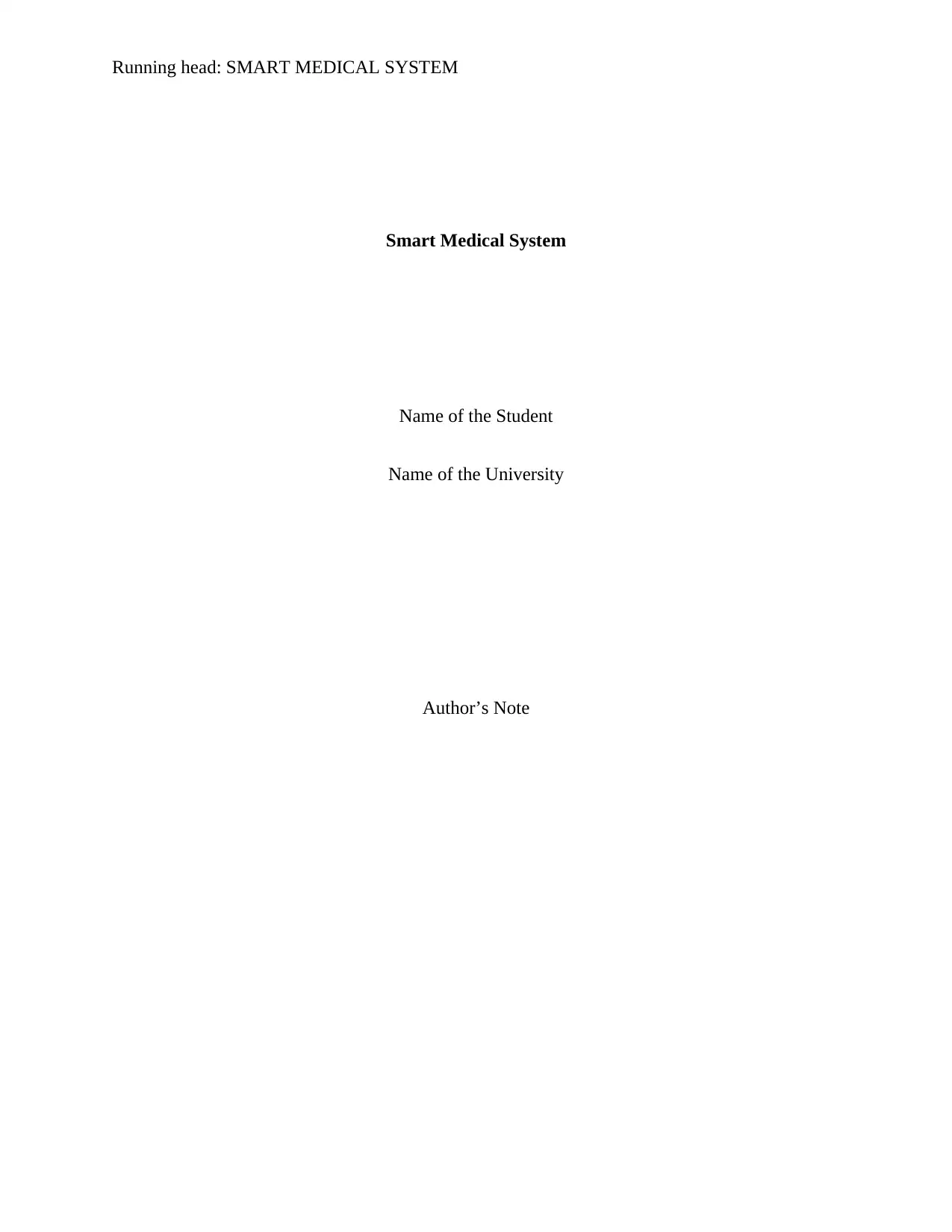
Running head: SMART MEDICAL SYSTEM
Smart Medical System
Name of the Student
Name of the University
Author’s Note
Smart Medical System
Name of the Student
Name of the University
Author’s Note
Paraphrase This Document
Need a fresh take? Get an instant paraphrase of this document with our AI Paraphraser
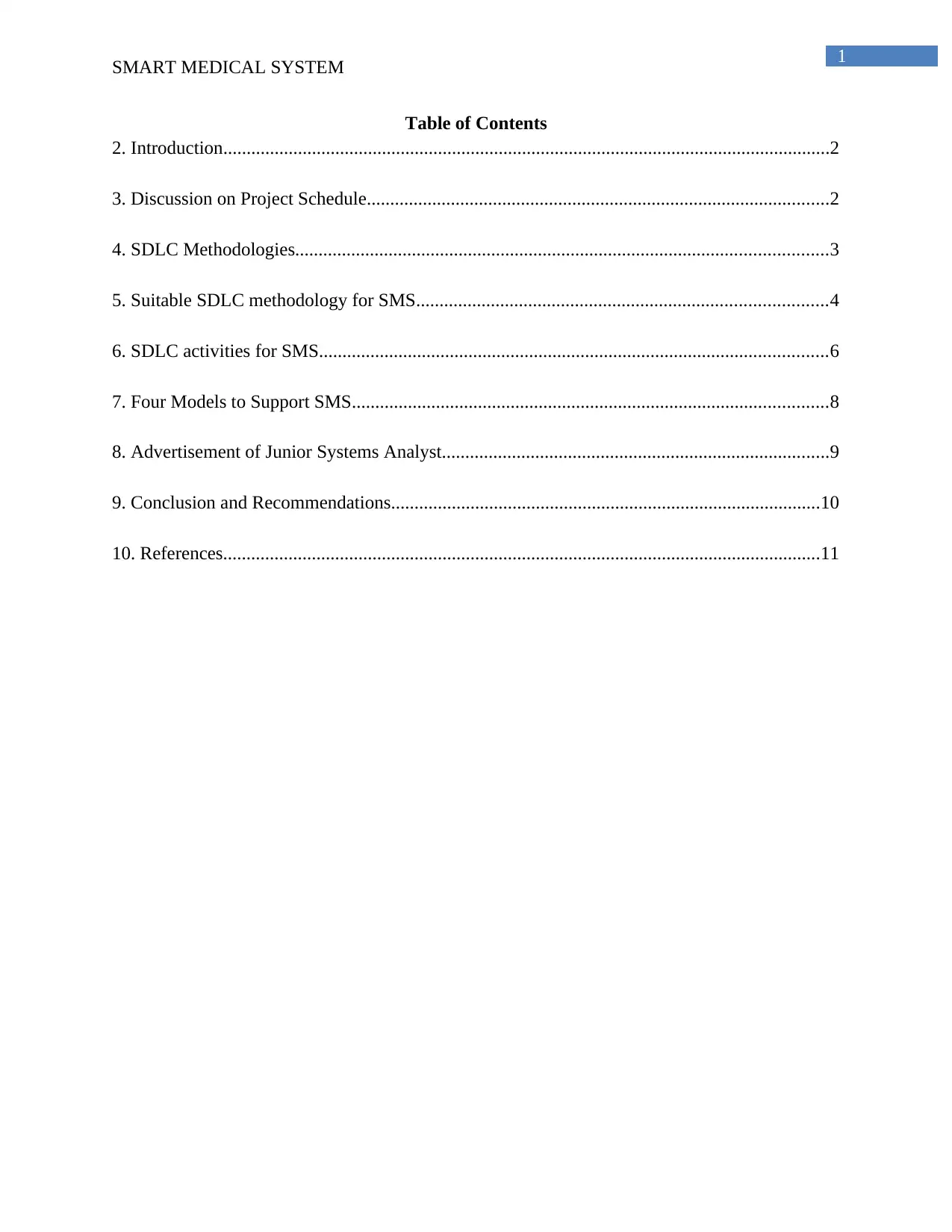
1
SMART MEDICAL SYSTEM
Table of Contents
2. Introduction..................................................................................................................................2
3. Discussion on Project Schedule...................................................................................................2
4. SDLC Methodologies..................................................................................................................3
5. Suitable SDLC methodology for SMS........................................................................................4
6. SDLC activities for SMS.............................................................................................................6
7. Four Models to Support SMS......................................................................................................8
8. Advertisement of Junior Systems Analyst...................................................................................9
9. Conclusion and Recommendations............................................................................................10
10. References................................................................................................................................11
SMART MEDICAL SYSTEM
Table of Contents
2. Introduction..................................................................................................................................2
3. Discussion on Project Schedule...................................................................................................2
4. SDLC Methodologies..................................................................................................................3
5. Suitable SDLC methodology for SMS........................................................................................4
6. SDLC activities for SMS.............................................................................................................6
7. Four Models to Support SMS......................................................................................................8
8. Advertisement of Junior Systems Analyst...................................................................................9
9. Conclusion and Recommendations............................................................................................10
10. References................................................................................................................................11
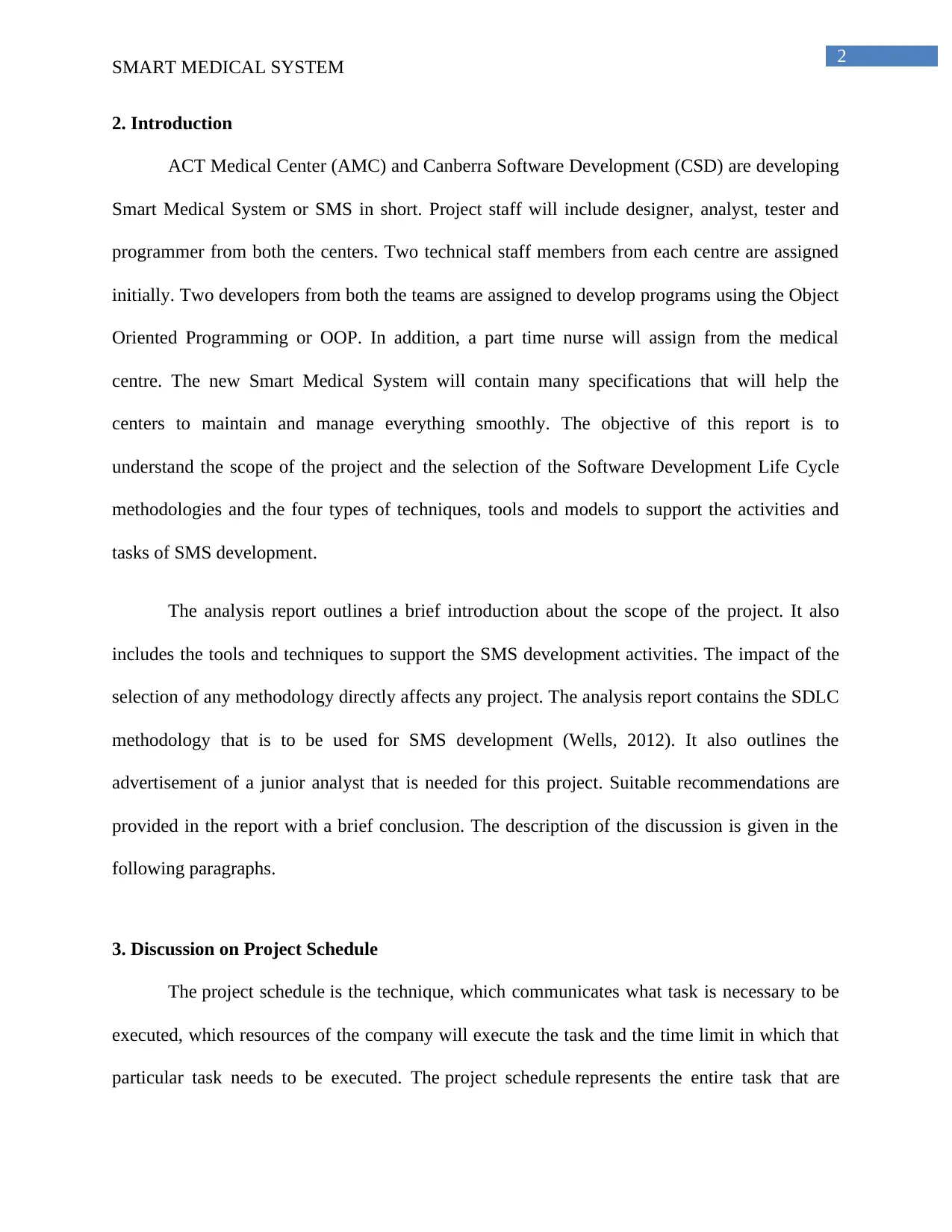
2
SMART MEDICAL SYSTEM
2. Introduction
ACT Medical Center (AMC) and Canberra Software Development (CSD) are developing
Smart Medical System or SMS in short. Project staff will include designer, analyst, tester and
programmer from both the centers. Two technical staff members from each centre are assigned
initially. Two developers from both the teams are assigned to develop programs using the Object
Oriented Programming or OOP. In addition, a part time nurse will assign from the medical
centre. The new Smart Medical System will contain many specifications that will help the
centers to maintain and manage everything smoothly. The objective of this report is to
understand the scope of the project and the selection of the Software Development Life Cycle
methodologies and the four types of techniques, tools and models to support the activities and
tasks of SMS development.
The analysis report outlines a brief introduction about the scope of the project. It also
includes the tools and techniques to support the SMS development activities. The impact of the
selection of any methodology directly affects any project. The analysis report contains the SDLC
methodology that is to be used for SMS development (Wells, 2012). It also outlines the
advertisement of a junior analyst that is needed for this project. Suitable recommendations are
provided in the report with a brief conclusion. The description of the discussion is given in the
following paragraphs.
3. Discussion on Project Schedule
The project schedule is the technique, which communicates what task is necessary to be
executed, which resources of the company will execute the task and the time limit in which that
particular task needs to be executed. The project schedule represents the entire task that are
SMART MEDICAL SYSTEM
2. Introduction
ACT Medical Center (AMC) and Canberra Software Development (CSD) are developing
Smart Medical System or SMS in short. Project staff will include designer, analyst, tester and
programmer from both the centers. Two technical staff members from each centre are assigned
initially. Two developers from both the teams are assigned to develop programs using the Object
Oriented Programming or OOP. In addition, a part time nurse will assign from the medical
centre. The new Smart Medical System will contain many specifications that will help the
centers to maintain and manage everything smoothly. The objective of this report is to
understand the scope of the project and the selection of the Software Development Life Cycle
methodologies and the four types of techniques, tools and models to support the activities and
tasks of SMS development.
The analysis report outlines a brief introduction about the scope of the project. It also
includes the tools and techniques to support the SMS development activities. The impact of the
selection of any methodology directly affects any project. The analysis report contains the SDLC
methodology that is to be used for SMS development (Wells, 2012). It also outlines the
advertisement of a junior analyst that is needed for this project. Suitable recommendations are
provided in the report with a brief conclusion. The description of the discussion is given in the
following paragraphs.
3. Discussion on Project Schedule
The project schedule is the technique, which communicates what task is necessary to be
executed, which resources of the company will execute the task and the time limit in which that
particular task needs to be executed. The project schedule represents the entire task that are
⊘ This is a preview!⊘
Do you want full access?
Subscribe today to unlock all pages.

Trusted by 1+ million students worldwide
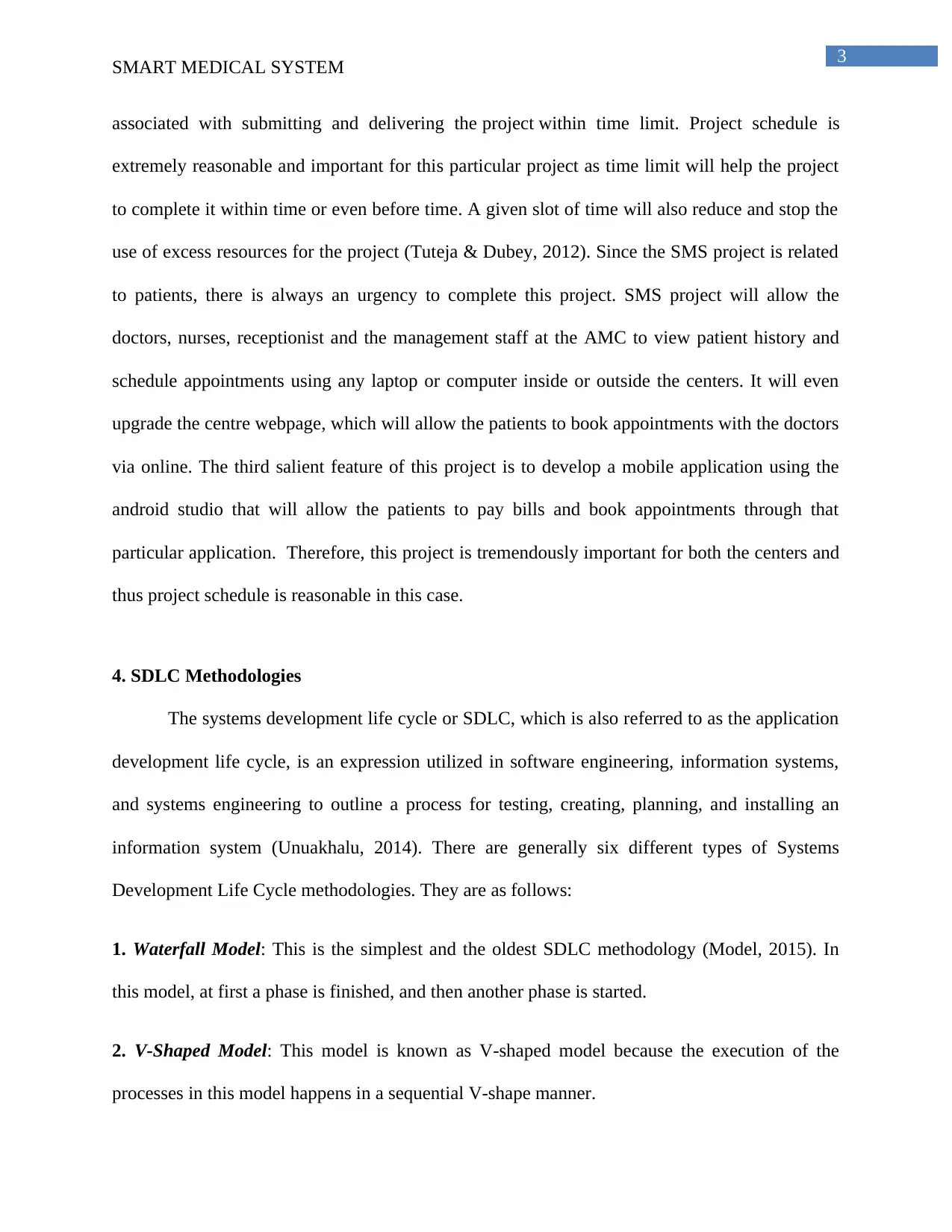
3
SMART MEDICAL SYSTEM
associated with submitting and delivering the project within time limit. Project schedule is
extremely reasonable and important for this particular project as time limit will help the project
to complete it within time or even before time. A given slot of time will also reduce and stop the
use of excess resources for the project (Tuteja & Dubey, 2012). Since the SMS project is related
to patients, there is always an urgency to complete this project. SMS project will allow the
doctors, nurses, receptionist and the management staff at the AMC to view patient history and
schedule appointments using any laptop or computer inside or outside the centers. It will even
upgrade the centre webpage, which will allow the patients to book appointments with the doctors
via online. The third salient feature of this project is to develop a mobile application using the
android studio that will allow the patients to pay bills and book appointments through that
particular application. Therefore, this project is tremendously important for both the centers and
thus project schedule is reasonable in this case.
4. SDLC Methodologies
The systems development life cycle or SDLC, which is also referred to as the application
development life cycle, is an expression utilized in software engineering, information systems,
and systems engineering to outline a process for testing, creating, planning, and installing an
information system (Unuakhalu, 2014). There are generally six different types of Systems
Development Life Cycle methodologies. They are as follows:
1. Waterfall Model: This is the simplest and the oldest SDLC methodology (Model, 2015). In
this model, at first a phase is finished, and then another phase is started.
2. V-Shaped Model: This model is known as V-shaped model because the execution of the
processes in this model happens in a sequential V-shape manner.
SMART MEDICAL SYSTEM
associated with submitting and delivering the project within time limit. Project schedule is
extremely reasonable and important for this particular project as time limit will help the project
to complete it within time or even before time. A given slot of time will also reduce and stop the
use of excess resources for the project (Tuteja & Dubey, 2012). Since the SMS project is related
to patients, there is always an urgency to complete this project. SMS project will allow the
doctors, nurses, receptionist and the management staff at the AMC to view patient history and
schedule appointments using any laptop or computer inside or outside the centers. It will even
upgrade the centre webpage, which will allow the patients to book appointments with the doctors
via online. The third salient feature of this project is to develop a mobile application using the
android studio that will allow the patients to pay bills and book appointments through that
particular application. Therefore, this project is tremendously important for both the centers and
thus project schedule is reasonable in this case.
4. SDLC Methodologies
The systems development life cycle or SDLC, which is also referred to as the application
development life cycle, is an expression utilized in software engineering, information systems,
and systems engineering to outline a process for testing, creating, planning, and installing an
information system (Unuakhalu, 2014). There are generally six different types of Systems
Development Life Cycle methodologies. They are as follows:
1. Waterfall Model: This is the simplest and the oldest SDLC methodology (Model, 2015). In
this model, at first a phase is finished, and then another phase is started.
2. V-Shaped Model: This model is known as V-shaped model because the execution of the
processes in this model happens in a sequential V-shape manner.
Paraphrase This Document
Need a fresh take? Get an instant paraphrase of this document with our AI Paraphraser
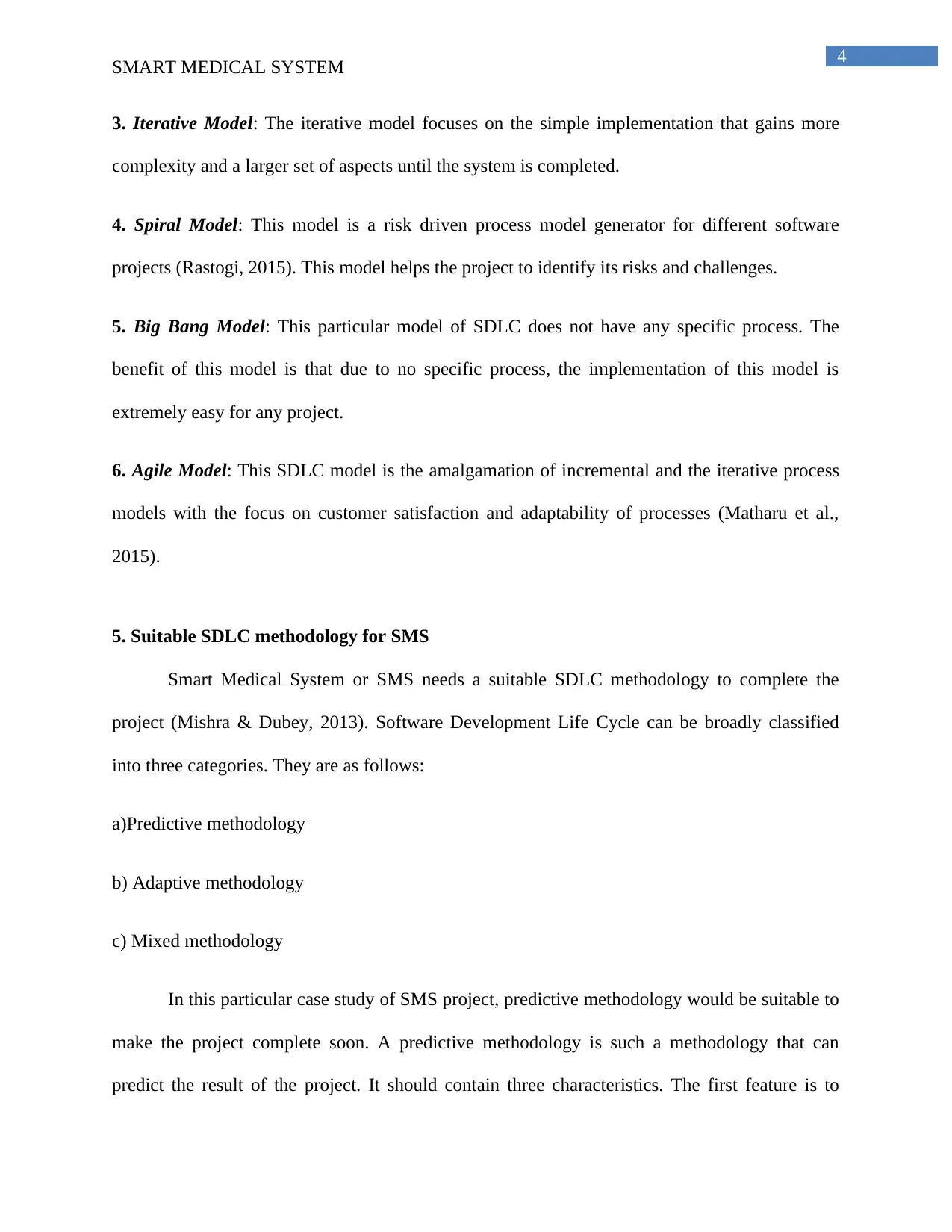
4
SMART MEDICAL SYSTEM
3. Iterative Model: The iterative model focuses on the simple implementation that gains more
complexity and a larger set of aspects until the system is completed.
4. Spiral Model: This model is a risk driven process model generator for different software
projects (Rastogi, 2015). This model helps the project to identify its risks and challenges.
5. Big Bang Model: This particular model of SDLC does not have any specific process. The
benefit of this model is that due to no specific process, the implementation of this model is
extremely easy for any project.
6. Agile Model: This SDLC model is the amalgamation of incremental and the iterative process
models with the focus on customer satisfaction and adaptability of processes (Matharu et al.,
2015).
5. Suitable SDLC methodology for SMS
Smart Medical System or SMS needs a suitable SDLC methodology to complete the
project (Mishra & Dubey, 2013). Software Development Life Cycle can be broadly classified
into three categories. They are as follows:
a)Predictive methodology
b) Adaptive methodology
c) Mixed methodology
In this particular case study of SMS project, predictive methodology would be suitable to
make the project complete soon. A predictive methodology is such a methodology that can
predict the result of the project. It should contain three characteristics. The first feature is to
SMART MEDICAL SYSTEM
3. Iterative Model: The iterative model focuses on the simple implementation that gains more
complexity and a larger set of aspects until the system is completed.
4. Spiral Model: This model is a risk driven process model generator for different software
projects (Rastogi, 2015). This model helps the project to identify its risks and challenges.
5. Big Bang Model: This particular model of SDLC does not have any specific process. The
benefit of this model is that due to no specific process, the implementation of this model is
extremely easy for any project.
6. Agile Model: This SDLC model is the amalgamation of incremental and the iterative process
models with the focus on customer satisfaction and adaptability of processes (Matharu et al.,
2015).
5. Suitable SDLC methodology for SMS
Smart Medical System or SMS needs a suitable SDLC methodology to complete the
project (Mishra & Dubey, 2013). Software Development Life Cycle can be broadly classified
into three categories. They are as follows:
a)Predictive methodology
b) Adaptive methodology
c) Mixed methodology
In this particular case study of SMS project, predictive methodology would be suitable to
make the project complete soon. A predictive methodology is such a methodology that can
predict the result of the project. It should contain three characteristics. The first feature is to
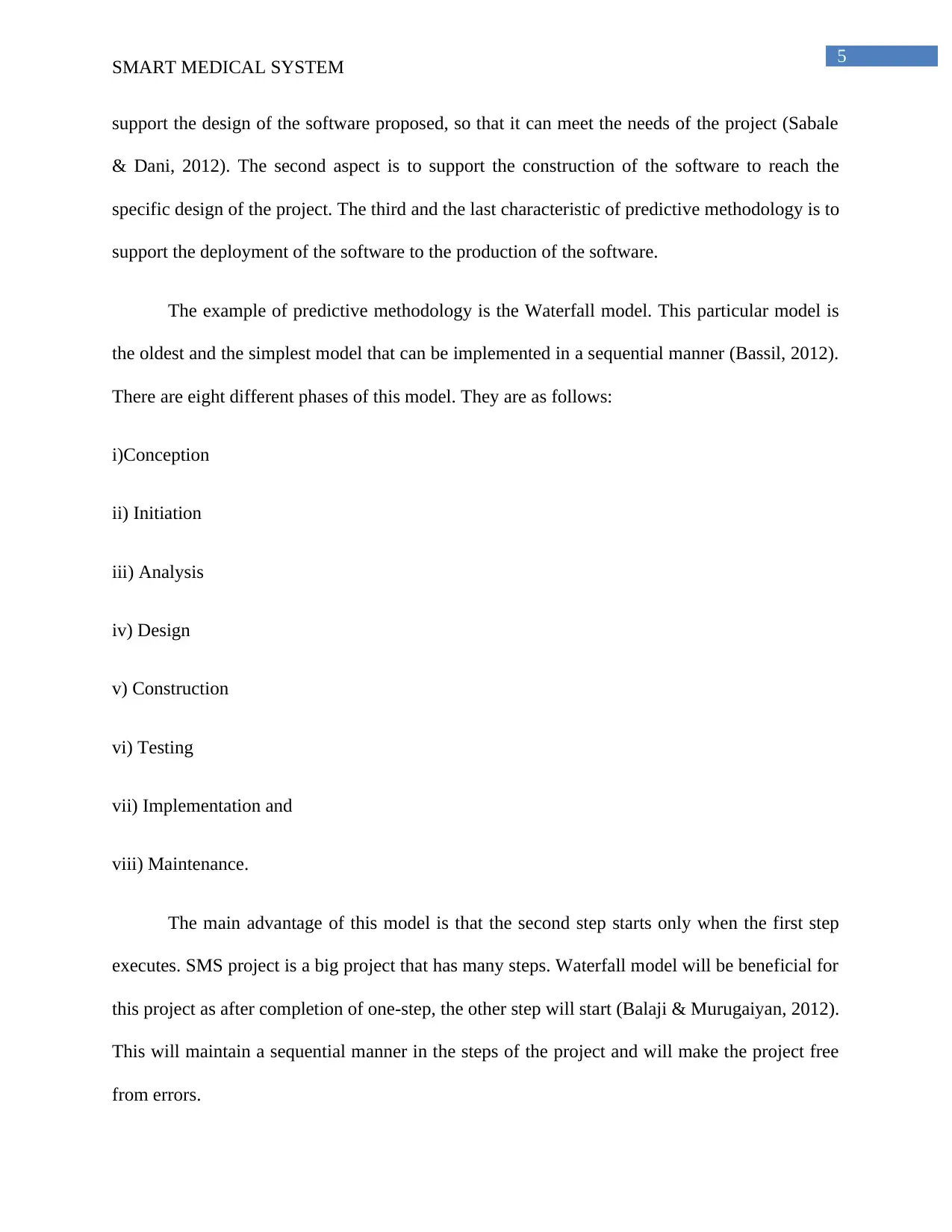
5
SMART MEDICAL SYSTEM
support the design of the software proposed, so that it can meet the needs of the project (Sabale
& Dani, 2012). The second aspect is to support the construction of the software to reach the
specific design of the project. The third and the last characteristic of predictive methodology is to
support the deployment of the software to the production of the software.
The example of predictive methodology is the Waterfall model. This particular model is
the oldest and the simplest model that can be implemented in a sequential manner (Bassil, 2012).
There are eight different phases of this model. They are as follows:
i)Conception
ii) Initiation
iii) Analysis
iv) Design
v) Construction
vi) Testing
vii) Implementation and
viii) Maintenance.
The main advantage of this model is that the second step starts only when the first step
executes. SMS project is a big project that has many steps. Waterfall model will be beneficial for
this project as after completion of one-step, the other step will start (Balaji & Murugaiyan, 2012).
This will maintain a sequential manner in the steps of the project and will make the project free
from errors.
SMART MEDICAL SYSTEM
support the design of the software proposed, so that it can meet the needs of the project (Sabale
& Dani, 2012). The second aspect is to support the construction of the software to reach the
specific design of the project. The third and the last characteristic of predictive methodology is to
support the deployment of the software to the production of the software.
The example of predictive methodology is the Waterfall model. This particular model is
the oldest and the simplest model that can be implemented in a sequential manner (Bassil, 2012).
There are eight different phases of this model. They are as follows:
i)Conception
ii) Initiation
iii) Analysis
iv) Design
v) Construction
vi) Testing
vii) Implementation and
viii) Maintenance.
The main advantage of this model is that the second step starts only when the first step
executes. SMS project is a big project that has many steps. Waterfall model will be beneficial for
this project as after completion of one-step, the other step will start (Balaji & Murugaiyan, 2012).
This will maintain a sequential manner in the steps of the project and will make the project free
from errors.
⊘ This is a preview!⊘
Do you want full access?
Subscribe today to unlock all pages.

Trusted by 1+ million students worldwide
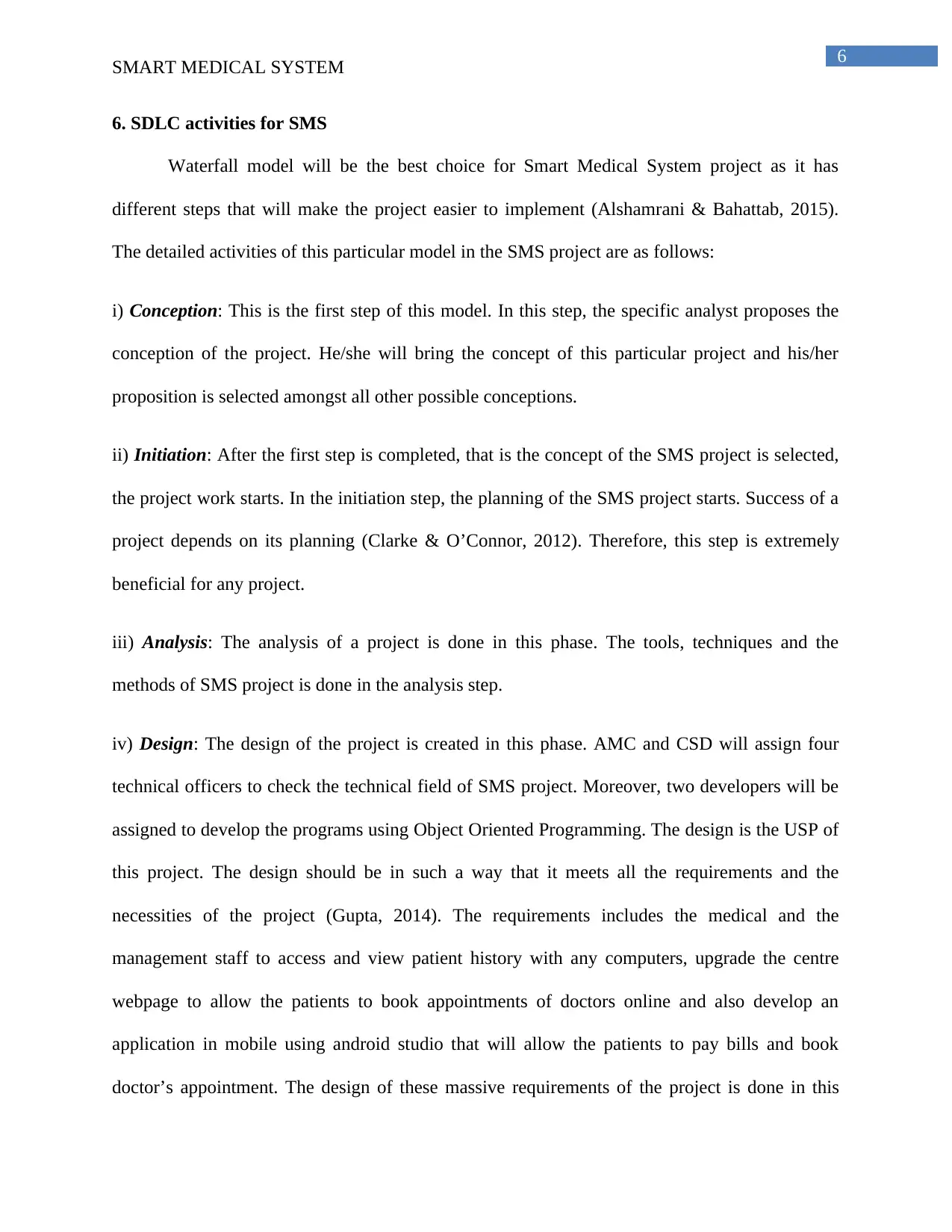
6
SMART MEDICAL SYSTEM
6. SDLC activities for SMS
Waterfall model will be the best choice for Smart Medical System project as it has
different steps that will make the project easier to implement (Alshamrani & Bahattab, 2015).
The detailed activities of this particular model in the SMS project are as follows:
i) Conception: This is the first step of this model. In this step, the specific analyst proposes the
conception of the project. He/she will bring the concept of this particular project and his/her
proposition is selected amongst all other possible conceptions.
ii) Initiation: After the first step is completed, that is the concept of the SMS project is selected,
the project work starts. In the initiation step, the planning of the SMS project starts. Success of a
project depends on its planning (Clarke & O’Connor, 2012). Therefore, this step is extremely
beneficial for any project.
iii) Analysis: The analysis of a project is done in this phase. The tools, techniques and the
methods of SMS project is done in the analysis step.
iv) Design: The design of the project is created in this phase. AMC and CSD will assign four
technical officers to check the technical field of SMS project. Moreover, two developers will be
assigned to develop the programs using Object Oriented Programming. The design is the USP of
this project. The design should be in such a way that it meets all the requirements and the
necessities of the project (Gupta, 2014). The requirements includes the medical and the
management staff to access and view patient history with any computers, upgrade the centre
webpage to allow the patients to book appointments of doctors online and also develop an
application in mobile using android studio that will allow the patients to pay bills and book
doctor’s appointment. The design of these massive requirements of the project is done in this
SMART MEDICAL SYSTEM
6. SDLC activities for SMS
Waterfall model will be the best choice for Smart Medical System project as it has
different steps that will make the project easier to implement (Alshamrani & Bahattab, 2015).
The detailed activities of this particular model in the SMS project are as follows:
i) Conception: This is the first step of this model. In this step, the specific analyst proposes the
conception of the project. He/she will bring the concept of this particular project and his/her
proposition is selected amongst all other possible conceptions.
ii) Initiation: After the first step is completed, that is the concept of the SMS project is selected,
the project work starts. In the initiation step, the planning of the SMS project starts. Success of a
project depends on its planning (Clarke & O’Connor, 2012). Therefore, this step is extremely
beneficial for any project.
iii) Analysis: The analysis of a project is done in this phase. The tools, techniques and the
methods of SMS project is done in the analysis step.
iv) Design: The design of the project is created in this phase. AMC and CSD will assign four
technical officers to check the technical field of SMS project. Moreover, two developers will be
assigned to develop the programs using Object Oriented Programming. The design is the USP of
this project. The design should be in such a way that it meets all the requirements and the
necessities of the project (Gupta, 2014). The requirements includes the medical and the
management staff to access and view patient history with any computers, upgrade the centre
webpage to allow the patients to book appointments of doctors online and also develop an
application in mobile using android studio that will allow the patients to pay bills and book
doctor’s appointment. The design of these massive requirements of the project is done in this
Paraphrase This Document
Need a fresh take? Get an instant paraphrase of this document with our AI Paraphraser
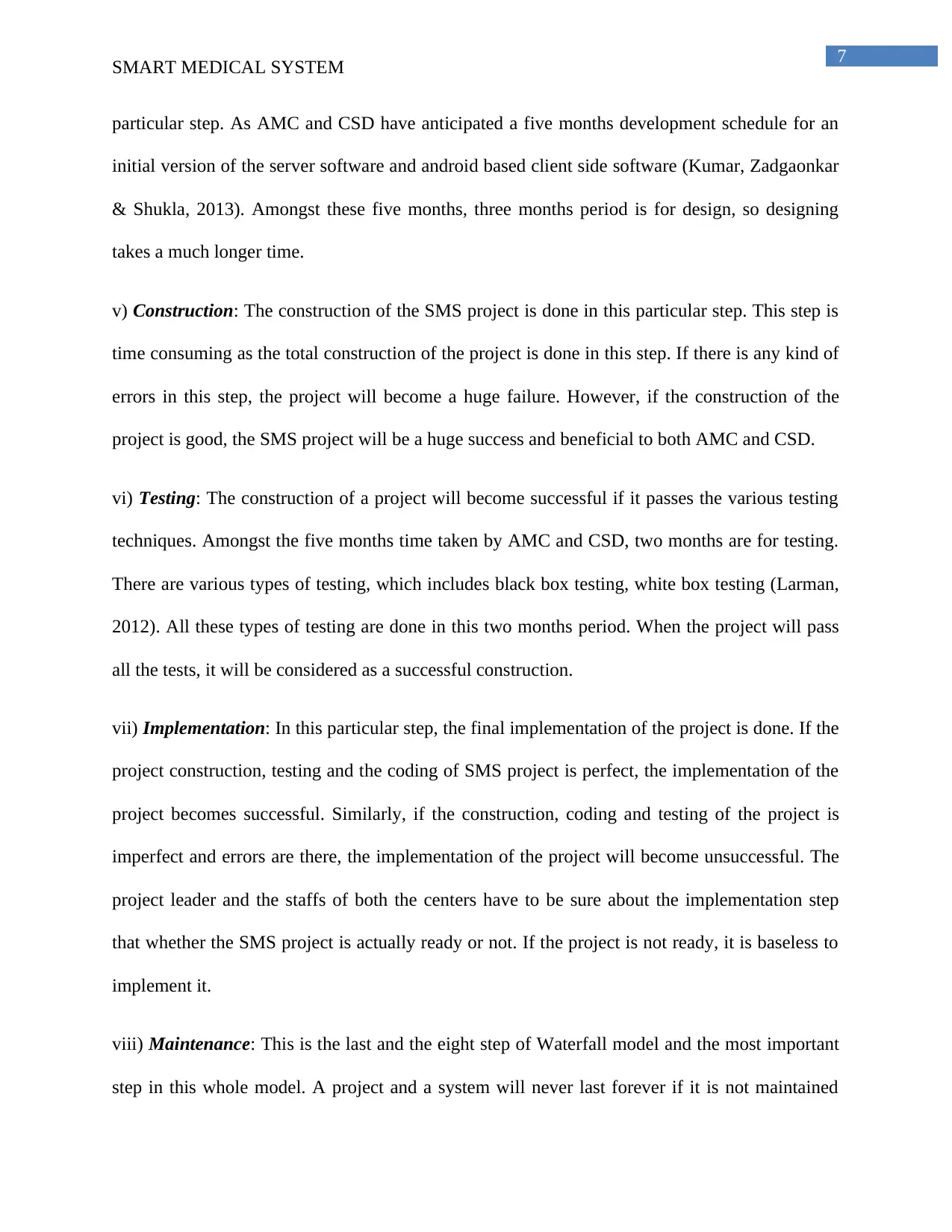
7
SMART MEDICAL SYSTEM
particular step. As AMC and CSD have anticipated a five months development schedule for an
initial version of the server software and android based client side software (Kumar, Zadgaonkar
& Shukla, 2013). Amongst these five months, three months period is for design, so designing
takes a much longer time.
v) Construction: The construction of the SMS project is done in this particular step. This step is
time consuming as the total construction of the project is done in this step. If there is any kind of
errors in this step, the project will become a huge failure. However, if the construction of the
project is good, the SMS project will be a huge success and beneficial to both AMC and CSD.
vi) Testing: The construction of a project will become successful if it passes the various testing
techniques. Amongst the five months time taken by AMC and CSD, two months are for testing.
There are various types of testing, which includes black box testing, white box testing (Larman,
2012). All these types of testing are done in this two months period. When the project will pass
all the tests, it will be considered as a successful construction.
vii) Implementation: In this particular step, the final implementation of the project is done. If the
project construction, testing and the coding of SMS project is perfect, the implementation of the
project becomes successful. Similarly, if the construction, coding and testing of the project is
imperfect and errors are there, the implementation of the project will become unsuccessful. The
project leader and the staffs of both the centers have to be sure about the implementation step
that whether the SMS project is actually ready or not. If the project is not ready, it is baseless to
implement it.
viii) Maintenance: This is the last and the eight step of Waterfall model and the most important
step in this whole model. A project and a system will never last forever if it is not maintained
SMART MEDICAL SYSTEM
particular step. As AMC and CSD have anticipated a five months development schedule for an
initial version of the server software and android based client side software (Kumar, Zadgaonkar
& Shukla, 2013). Amongst these five months, three months period is for design, so designing
takes a much longer time.
v) Construction: The construction of the SMS project is done in this particular step. This step is
time consuming as the total construction of the project is done in this step. If there is any kind of
errors in this step, the project will become a huge failure. However, if the construction of the
project is good, the SMS project will be a huge success and beneficial to both AMC and CSD.
vi) Testing: The construction of a project will become successful if it passes the various testing
techniques. Amongst the five months time taken by AMC and CSD, two months are for testing.
There are various types of testing, which includes black box testing, white box testing (Larman,
2012). All these types of testing are done in this two months period. When the project will pass
all the tests, it will be considered as a successful construction.
vii) Implementation: In this particular step, the final implementation of the project is done. If the
project construction, testing and the coding of SMS project is perfect, the implementation of the
project becomes successful. Similarly, if the construction, coding and testing of the project is
imperfect and errors are there, the implementation of the project will become unsuccessful. The
project leader and the staffs of both the centers have to be sure about the implementation step
that whether the SMS project is actually ready or not. If the project is not ready, it is baseless to
implement it.
viii) Maintenance: This is the last and the eight step of Waterfall model and the most important
step in this whole model. A project and a system will never last forever if it is not maintained
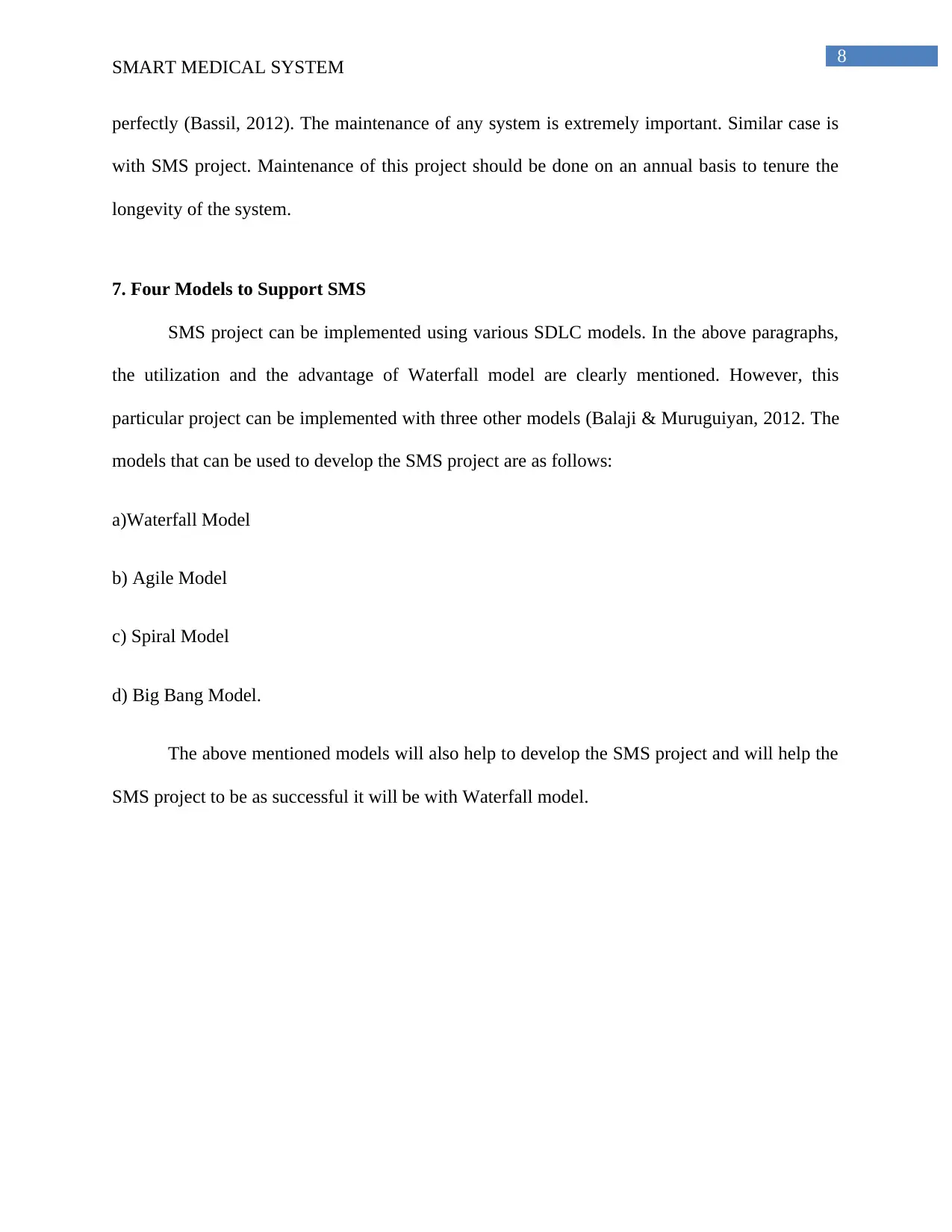
8
SMART MEDICAL SYSTEM
perfectly (Bassil, 2012). The maintenance of any system is extremely important. Similar case is
with SMS project. Maintenance of this project should be done on an annual basis to tenure the
longevity of the system.
7. Four Models to Support SMS
SMS project can be implemented using various SDLC models. In the above paragraphs,
the utilization and the advantage of Waterfall model are clearly mentioned. However, this
particular project can be implemented with three other models (Balaji & Muruguiyan, 2012. The
models that can be used to develop the SMS project are as follows:
a)Waterfall Model
b) Agile Model
c) Spiral Model
d) Big Bang Model.
The above mentioned models will also help to develop the SMS project and will help the
SMS project to be as successful it will be with Waterfall model.
SMART MEDICAL SYSTEM
perfectly (Bassil, 2012). The maintenance of any system is extremely important. Similar case is
with SMS project. Maintenance of this project should be done on an annual basis to tenure the
longevity of the system.
7. Four Models to Support SMS
SMS project can be implemented using various SDLC models. In the above paragraphs,
the utilization and the advantage of Waterfall model are clearly mentioned. However, this
particular project can be implemented with three other models (Balaji & Muruguiyan, 2012. The
models that can be used to develop the SMS project are as follows:
a)Waterfall Model
b) Agile Model
c) Spiral Model
d) Big Bang Model.
The above mentioned models will also help to develop the SMS project and will help the
SMS project to be as successful it will be with Waterfall model.
⊘ This is a preview!⊘
Do you want full access?
Subscribe today to unlock all pages.

Trusted by 1+ million students worldwide
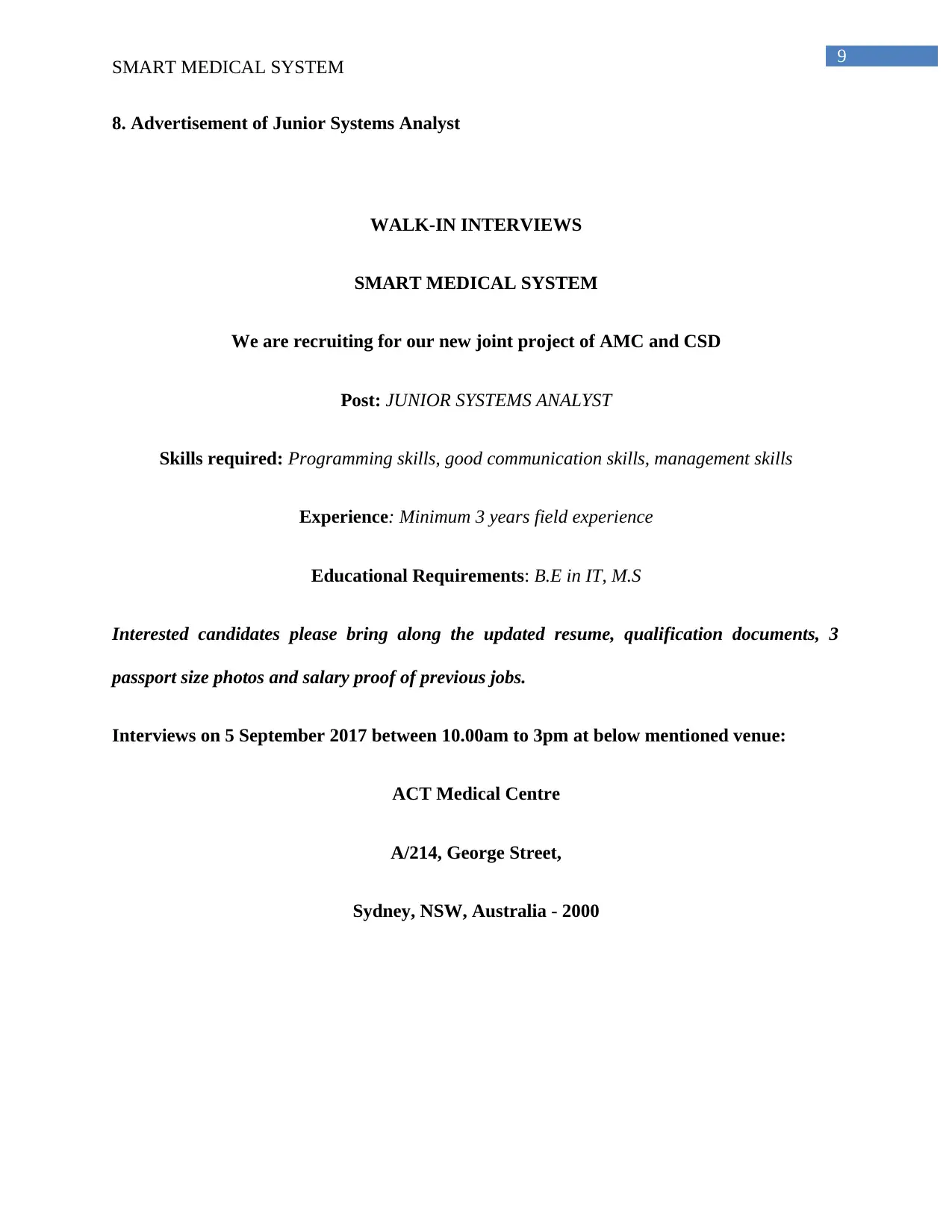
9
SMART MEDICAL SYSTEM
8. Advertisement of Junior Systems Analyst
WALK-IN INTERVIEWS
SMART MEDICAL SYSTEM
We are recruiting for our new joint project of AMC and CSD
Post: JUNIOR SYSTEMS ANALYST
Skills required: Programming skills, good communication skills, management skills
Experience: Minimum 3 years field experience
Educational Requirements: B.E in IT, M.S
Interested candidates please bring along the updated resume, qualification documents, 3
passport size photos and salary proof of previous jobs.
Interviews on 5 September 2017 between 10.00am to 3pm at below mentioned venue:
ACT Medical Centre
A/214, George Street,
Sydney, NSW, Australia - 2000
SMART MEDICAL SYSTEM
8. Advertisement of Junior Systems Analyst
WALK-IN INTERVIEWS
SMART MEDICAL SYSTEM
We are recruiting for our new joint project of AMC and CSD
Post: JUNIOR SYSTEMS ANALYST
Skills required: Programming skills, good communication skills, management skills
Experience: Minimum 3 years field experience
Educational Requirements: B.E in IT, M.S
Interested candidates please bring along the updated resume, qualification documents, 3
passport size photos and salary proof of previous jobs.
Interviews on 5 September 2017 between 10.00am to 3pm at below mentioned venue:
ACT Medical Centre
A/214, George Street,
Sydney, NSW, Australia - 2000
Paraphrase This Document
Need a fresh take? Get an instant paraphrase of this document with our AI Paraphraser
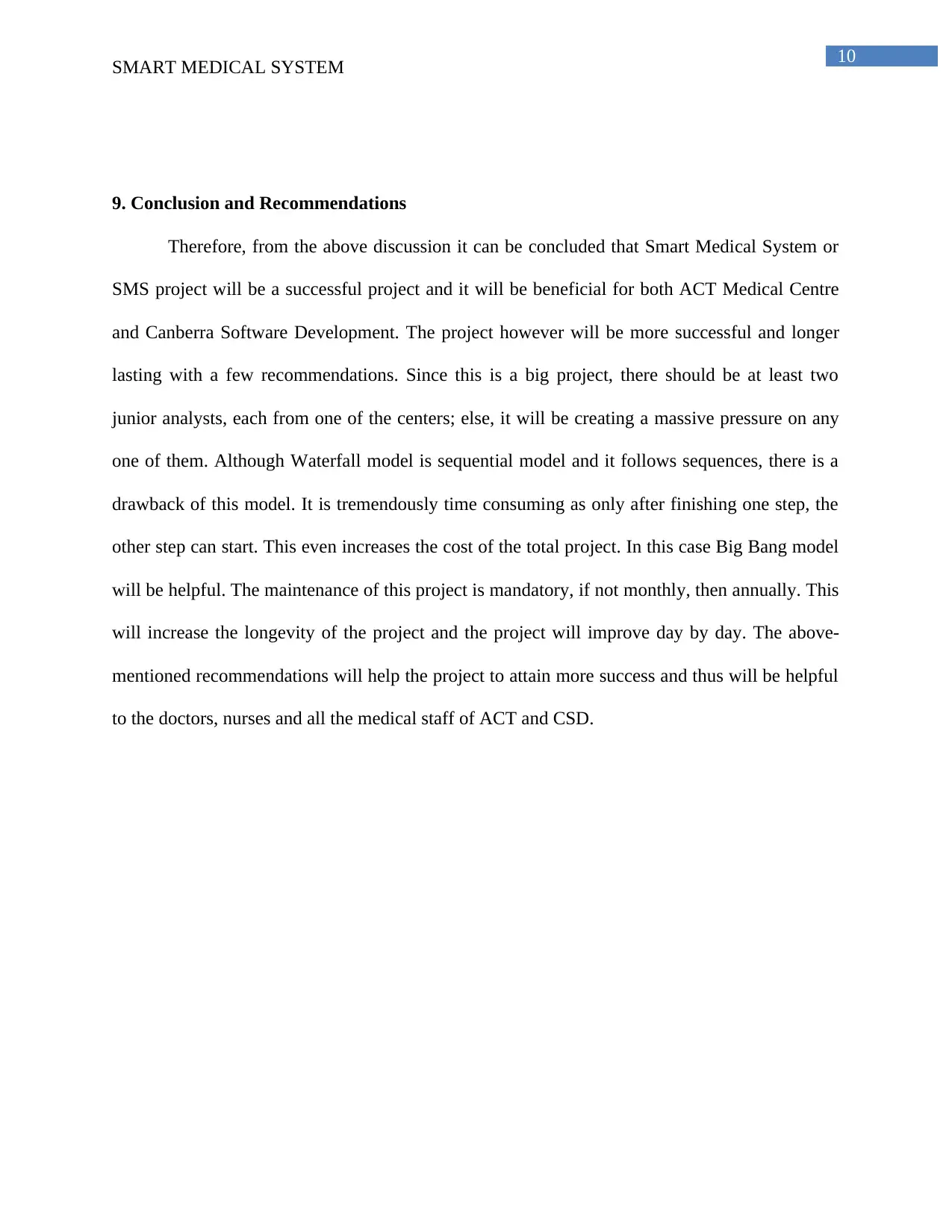
10
SMART MEDICAL SYSTEM
9. Conclusion and Recommendations
Therefore, from the above discussion it can be concluded that Smart Medical System or
SMS project will be a successful project and it will be beneficial for both ACT Medical Centre
and Canberra Software Development. The project however will be more successful and longer
lasting with a few recommendations. Since this is a big project, there should be at least two
junior analysts, each from one of the centers; else, it will be creating a massive pressure on any
one of them. Although Waterfall model is sequential model and it follows sequences, there is a
drawback of this model. It is tremendously time consuming as only after finishing one step, the
other step can start. This even increases the cost of the total project. In this case Big Bang model
will be helpful. The maintenance of this project is mandatory, if not monthly, then annually. This
will increase the longevity of the project and the project will improve day by day. The above-
mentioned recommendations will help the project to attain more success and thus will be helpful
to the doctors, nurses and all the medical staff of ACT and CSD.
SMART MEDICAL SYSTEM
9. Conclusion and Recommendations
Therefore, from the above discussion it can be concluded that Smart Medical System or
SMS project will be a successful project and it will be beneficial for both ACT Medical Centre
and Canberra Software Development. The project however will be more successful and longer
lasting with a few recommendations. Since this is a big project, there should be at least two
junior analysts, each from one of the centers; else, it will be creating a massive pressure on any
one of them. Although Waterfall model is sequential model and it follows sequences, there is a
drawback of this model. It is tremendously time consuming as only after finishing one step, the
other step can start. This even increases the cost of the total project. In this case Big Bang model
will be helpful. The maintenance of this project is mandatory, if not monthly, then annually. This
will increase the longevity of the project and the project will improve day by day. The above-
mentioned recommendations will help the project to attain more success and thus will be helpful
to the doctors, nurses and all the medical staff of ACT and CSD.
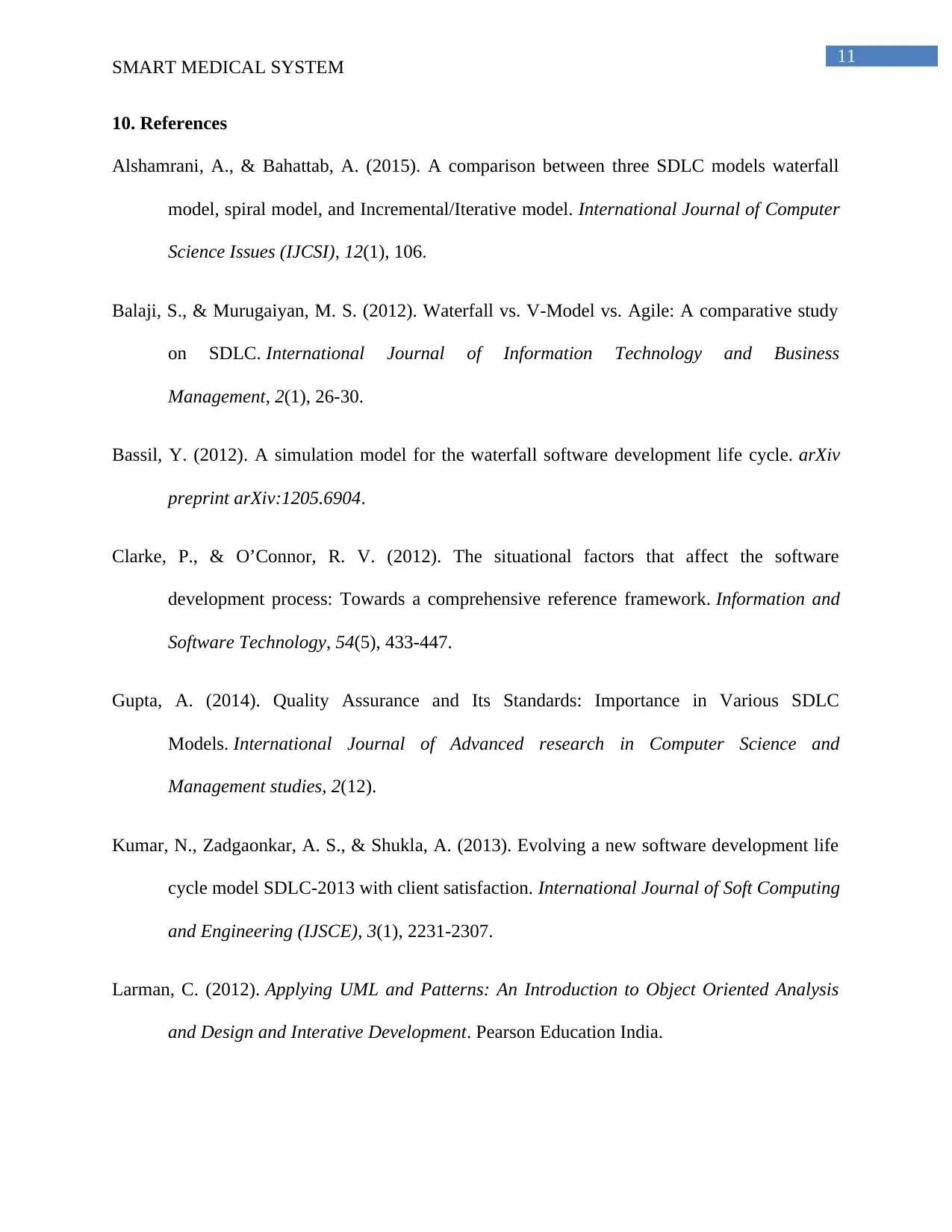
11
SMART MEDICAL SYSTEM
10. References
Alshamrani, A., & Bahattab, A. (2015). A comparison between three SDLC models waterfall
model, spiral model, and Incremental/Iterative model. International Journal of Computer
Science Issues (IJCSI), 12(1), 106.
Balaji, S., & Murugaiyan, M. S. (2012). Waterfall vs. V-Model vs. Agile: A comparative study
on SDLC. International Journal of Information Technology and Business
Management, 2(1), 26-30.
Bassil, Y. (2012). A simulation model for the waterfall software development life cycle. arXiv
preprint arXiv:1205.6904.
Clarke, P., & O’Connor, R. V. (2012). The situational factors that affect the software
development process: Towards a comprehensive reference framework. Information and
Software Technology, 54(5), 433-447.
Gupta, A. (2014). Quality Assurance and Its Standards: Importance in Various SDLC
Models. International Journal of Advanced research in Computer Science and
Management studies, 2(12).
Kumar, N., Zadgaonkar, A. S., & Shukla, A. (2013). Evolving a new software development life
cycle model SDLC-2013 with client satisfaction. International Journal of Soft Computing
and Engineering (IJSCE), 3(1), 2231-2307.
Larman, C. (2012). Applying UML and Patterns: An Introduction to Object Oriented Analysis
and Design and Interative Development. Pearson Education India.
SMART MEDICAL SYSTEM
10. References
Alshamrani, A., & Bahattab, A. (2015). A comparison between three SDLC models waterfall
model, spiral model, and Incremental/Iterative model. International Journal of Computer
Science Issues (IJCSI), 12(1), 106.
Balaji, S., & Murugaiyan, M. S. (2012). Waterfall vs. V-Model vs. Agile: A comparative study
on SDLC. International Journal of Information Technology and Business
Management, 2(1), 26-30.
Bassil, Y. (2012). A simulation model for the waterfall software development life cycle. arXiv
preprint arXiv:1205.6904.
Clarke, P., & O’Connor, R. V. (2012). The situational factors that affect the software
development process: Towards a comprehensive reference framework. Information and
Software Technology, 54(5), 433-447.
Gupta, A. (2014). Quality Assurance and Its Standards: Importance in Various SDLC
Models. International Journal of Advanced research in Computer Science and
Management studies, 2(12).
Kumar, N., Zadgaonkar, A. S., & Shukla, A. (2013). Evolving a new software development life
cycle model SDLC-2013 with client satisfaction. International Journal of Soft Computing
and Engineering (IJSCE), 3(1), 2231-2307.
Larman, C. (2012). Applying UML and Patterns: An Introduction to Object Oriented Analysis
and Design and Interative Development. Pearson Education India.
⊘ This is a preview!⊘
Do you want full access?
Subscribe today to unlock all pages.

Trusted by 1+ million students worldwide
1 out of 13
Related Documents
Your All-in-One AI-Powered Toolkit for Academic Success.
+13062052269
info@desklib.com
Available 24*7 on WhatsApp / Email
![[object Object]](/_next/static/media/star-bottom.7253800d.svg)
Unlock your academic potential
Copyright © 2020–2025 A2Z Services. All Rights Reserved. Developed and managed by ZUCOL.





